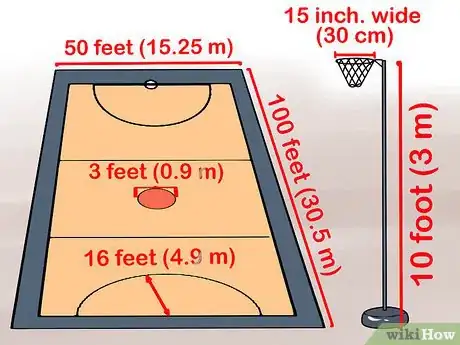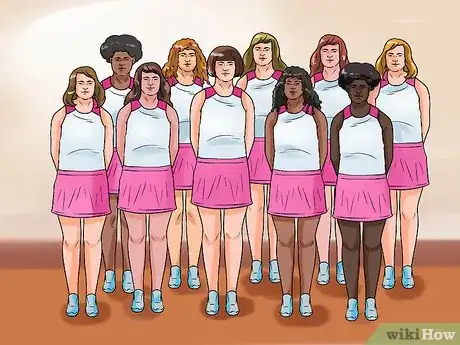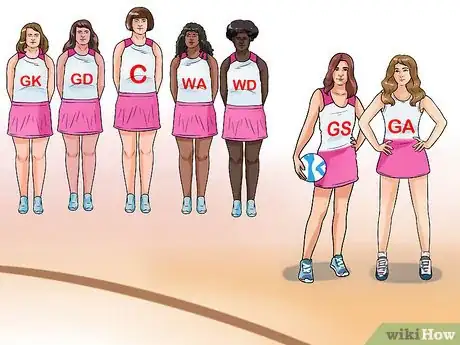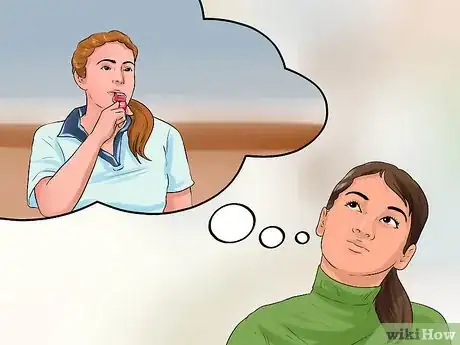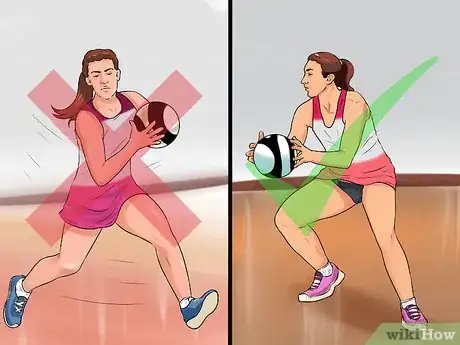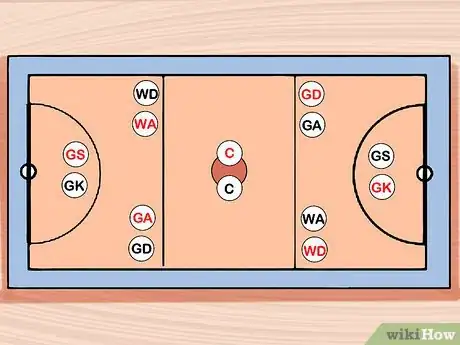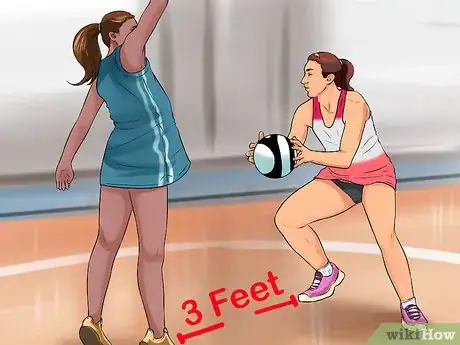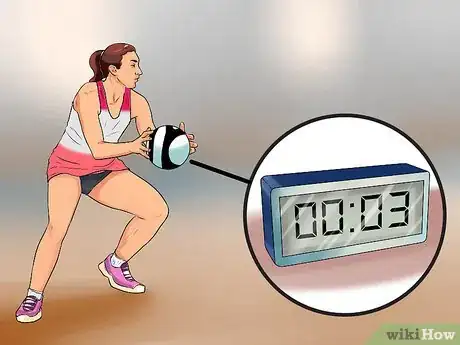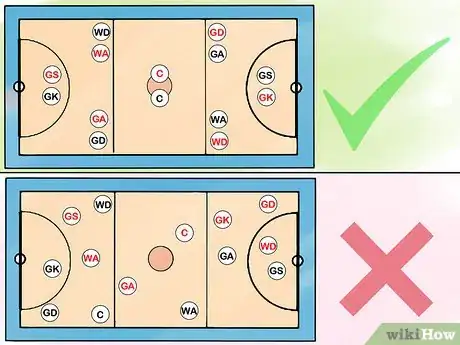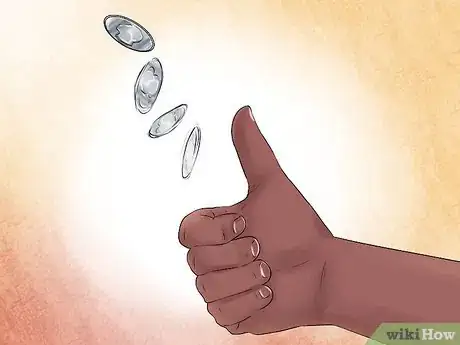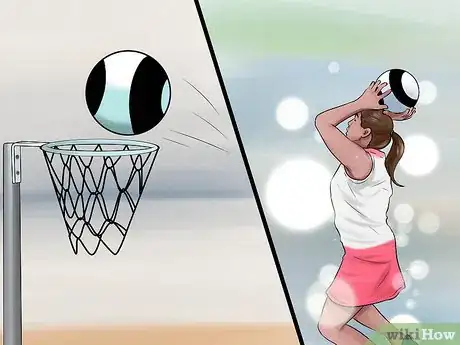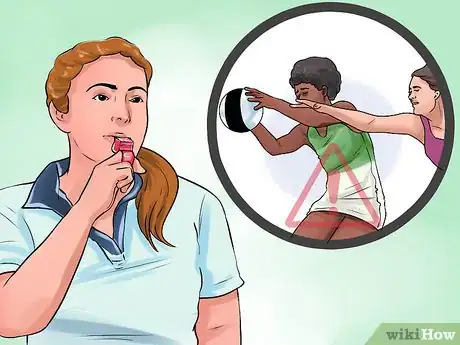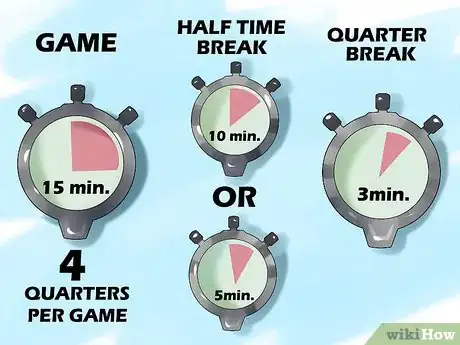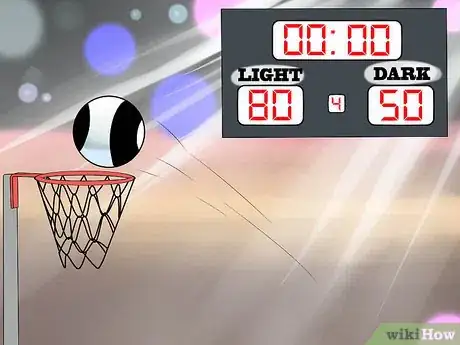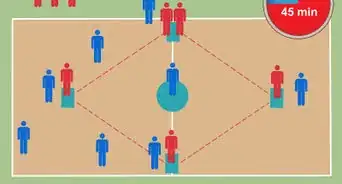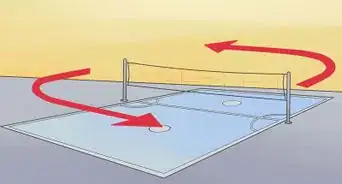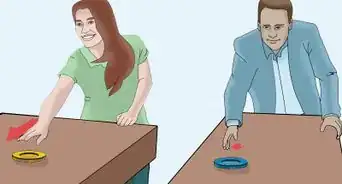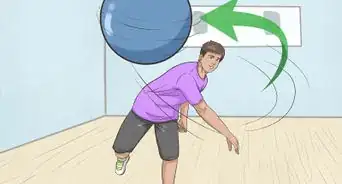wikiHow is a “wiki,” similar to Wikipedia, which means that many of our articles are co-written by multiple authors. To create this article, 44 people, some anonymous, worked to edit and improve it over time.
This article has been viewed 106,024 times.
Learn more...
First played in England in 1895, netball has spread to more than 70 countries. Played predominantly by women, the sport is similar to basketball. Two teams of 7 players try to shoot a rubber or leather ball, measuring 27 to 28 inches (67 to 77 cm) in circumference, into the other team's goal ring at either end of the court. The International Federation of Netball Associations is responsible for setting the rules.
Steps
Preparing to Play Netball
-
1Find an indoor or outdoor regulation netball court.[1] It measures 100 feet (30.5 meters) long and 50 feet (15.25 m) wide. The court has horizontal lines dividing it into thirds. There is a circle 3 feet (0.9 m) in diameter in the center of the court. There are 2 goal semicircles, each with a radius of 16 feet (4.9 m) at each end. The 15-inch-wide (38 cm) goal ring extends horizontally from a 10-foot (3 m) post located at the midpoint of each goal line. Not only is the hoop smaller than basketball, there's no backboard.
- If you're playing in your backyard try to set up a field of this general size. If you happen to be playing with only a few players, you can just do a timed competition. For example, a partnership can do 5 passes and 2 shots. Using a basketball is okay if you don't have a netball. The nets are pretty important, however, if you want to play the game properly, as it has a backboard and a much bigger ring. A basketball, however, is much larger and heavier than a netball, so there would be some other differences.
-
2Form two teams of 7 players. If you have over 14 players, have some as subs and rotate them in. You can also play High-5 netball where there are no Wings in the game.Advertisement
-
3Assign positions to the players. Only 2 players, identified by the insignia GS (Goal Shooter) and GA (Goal Attack), can score. The other 5 positions are Goalkeeper (GK), Goal Defense (GD), Wing Attack (WA), Wing Defense (WD) and Center (C). These identification letters are displayed on the front and back of each player's jersey.[2]
- The center stands in the small circle in the center of the court. The center is both an attacker and defender because they are in the middle. They are allowed anywhere on the court other than the goal circles. The center circle has a diameter of ten yards.
- The wing attack position tries to feed the ball to the goal shooters. They are positioned at the top third of the field toward the opponent’s goal. The wing attack position is not allowed in the goal circle.
- Wing defenders defend against the wing attack position, trying to keep the ball out of their third of the court. Wing defenders are allowed in the center third and their own third, but not the goal circle.
- The goal attack position is allowed to shoot the ball at the goal and also pass it to the goal shooters in the goal circle. These players are allowed in the center third, the opponents third, and the goal circle.
- The goal defense position defends against the goal attack position. They are allowed in all the same areas as the goal attack position.
- The goal shoot position is only allowed in the opposing team's goal circle and the opponent's third. Their job is to catch passes from their other two attacking teammates and try to shoot on the goal.
- The goal keeper is only allowed in their own goal circle and their own defending third. They must stop the other players from getting the ball and shooting on the goal.
-
4Get a referee who knows the rules. You don’t need a referee if you’re just playing for fun, obviously, but if you wanted to organize a competitive game you should find an experienced netball player to act as a referee.
Learning the Rules
-
1Do not move at all with the ball. You cannot dribble, only pivot with the foot you land on first. The number one rule of netball is that you cannot travel with the ball. Although the game has some similarities to basketball, this rule is more like ultimate Frisbee. Basically, once you have the ball you can only pivot. You must always keep one foot in the same place.[3]
-
2Keep seven players from each team on the court at all times. The only exception to this is if a referee sends off a player from one team for an infraction.
-
3Stand one metre away from the player with the ball if you are a defender. You cannot be closer than one metre than the player, but you can be as far away as you want. Standing too close is an example of an obstruction. You can’t get in another player's face, and you have to give them room to survey the floor. You can jump up and down once and defend the pass, but you have to give them room to throw.[4]
- This means that you cannot snatch or grab the ball out of another player's hands. You can intercept the ball in the air, but if someone has control of the ball you must keep your distance.
-
4Follow the three-second ball possession rule. You are not allowed to hold the ball for more than three seconds at a time. Dropping the ball and picking it up again does not reset the possession clock. Similarly, if you try to pass to someone and miss and you grab the ball again the possession clock still does not end. If you hold the ball for more than three seconds you must give it up to the other team. In High-5 netball, the ball can be held for 4 seconds and the GS and GK can go in 2 thirds, the centre third and the one with the oppositions goal/ your goal.
-
5Remain in your designated position zone. Players must stay in position. You can’t run around like a free safety in football. You have to stay in the zones designated for your position.[5] Refer to the position list.
-
6Keep the ball in bounds. If the ball goes out of bounds, the team that touched the ball last must give the ball up to the other team. The other team picks up the ball and goes to the line where it went out.[6] They now have three seconds to throw it back into play once they reach this line.
Playing Netball
-
1Toss a coin. This is how you decide first possession of the ball or which goal end each team starts in. Whoever did not toss the coin calls the coin while it is in the air. If it lands on what they called, they get the ball. You can also do a throw up. A player from each team stands opposite each other, facing the way they are shooting, a metre away from each other in the centre circle. The coach or Umpire then tosses the ball up in between them and the first one to catch the ball decides whether they want the first center pass, or they can choose which way they want to shoot. [7]
-
2Begin play with a center pass. The Center (C) stands in the center circle and passes the ball to a teammate standing in the center third of the court. After each goal is scored, play resumes with another center pass.
-
3Score a goal. You can score a goal by shooting the ball through your team's goal ring while standing inside the goal circle. The other team's GK and GD will be protecting this net. The GA and GS players are allowed to score goals.
-
4Follow the major and minor rules of the game to avoid penalties. There are 2 umpires on the court, who make decisions during the game and call penalties.
- Major rules prohibit contact (accidental or deliberate), obstructing play, and intimidating your opponents. Should someone break a major rule, the offending player has to stand out of play while the other team throws a pass or shot from where the offense occurred.[8]
- Minor rules prohibit holding the ball for more than 3 seconds, stepping while in possession of the ball, moving out of the designated area for the position (offsides) or throwing the ball over a third of the court. Should an infringement on a minor rule occur, the other team gets a free pass from where the offense occurred.
-
5Play netball for 4 quarters, each 15 minutes long. There is a 5 or 10-minute break at halftime and a 3-minute break after the first and third quarters. You can also have 4 quarters which are 6 minutes long.
-
6Win the game. You win the game by scoring more goals than the other team before the game is over. Easier said than done!
Community Q&A
-
QuestionWhen I have the ball can I jump on my tiptoes to throw it?
 Community AnswerYour feet must remain on the ground at all times, otherwise this is a penalty against your team (it is known as stepping). Rolling onto your tiptoes without taking your foot off the ground is fine unless the umpire says otherwise.
Community AnswerYour feet must remain on the ground at all times, otherwise this is a penalty against your team (it is known as stepping). Rolling onto your tiptoes without taking your foot off the ground is fine unless the umpire says otherwise. -
QuestionIs netball a complicated sport?
 Community AnswerIf you are a beginner, it can be difficult for the first few weeks while you're learning the game.
Community AnswerIf you are a beginner, it can be difficult for the first few weeks while you're learning the game. -
QuestionCan the ball be snatched from opponents without touching their hands?
 Community AnswerThe ball cannot be snatched out of a players hand if they clearly have it in full grasp.
Community AnswerThe ball cannot be snatched out of a players hand if they clearly have it in full grasp.
References
- ↑ http://www.howtoplaynetball.com/netball-positions.php
- ↑ http://www.howtoplaynetball.com/netball-positions.php
- ↑ http://www.howtoplaynetball.com/rules-of-netball.php
- ↑ http://www.howtoplaynetball.com/rules-of-netball.php
- ↑ http://www.howtoplaynetball.com/rules-of-netball.php
- ↑ http://www.howtoplaynetball.com/rules-of-netball.php
- ↑ http://www.howtoplaynetball.com/rules-of-netball.php
- ↑ http://www.howtoplaynetball.com/rules-of-netball.php
About This Article
To play netball, start by breaking up into 2 teams of 7 players. Then, decide which 2 players on each team will be able to score, and have the rest of the players be on defense. To score in netball, shoot a ball through your team's goal ring while you're standing inside the goal circle. Keep in mind that you can't run or dribble with the ball, you can only pivot and pass it to another player. Also, don't hold onto the ball for longer than 3 seconds or you'll have to give it to the other team. To learn how to win in netball, scroll down!
